Tommaso Mario Buonocore
RAR: Setting Knowledge Tripwires for Retrieval Augmented Rejection
May 19, 2025Abstract:Content moderation for large language models (LLMs) remains a significant challenge, requiring flexible and adaptable solutions that can quickly respond to emerging threats. This paper introduces Retrieval Augmented Rejection (RAR), a novel approach that leverages a retrieval-augmented generation (RAG) architecture to dynamically reject unsafe user queries without model retraining. By strategically inserting and marking malicious documents into the vector database, the system can identify and reject harmful requests when these documents are retrieved. Our preliminary results show that RAR achieves comparable performance to embedded moderation in LLMs like Claude 3.5 Sonnet, while offering superior flexibility and real-time customization capabilities, a fundamental feature to timely address critical vulnerabilities. This approach introduces no architectural changes to existing RAG systems, requiring only the addition of specially crafted documents and a simple rejection mechanism based on retrieval results.
Igea: a Decoder-Only Language Model for Biomedical Text Generation in Italian
Jul 08, 2024



Abstract:The development of domain-specific language models has significantly advanced natural language processing applications in various specialized fields, particularly in biomedicine. However, the focus has largely been on English-language models, leaving a gap for less-resourced languages such as Italian. This paper introduces Igea, the first decoder-only language model designed explicitly for biomedical text generation in Italian. Built on the Minerva model and continually pretrained on a diverse corpus of Italian medical texts, Igea is available in three model sizes: 350 million, 1 billion, and 3 billion parameters. The models aim to balance computational efficiency and performance, addressing the challenges of managing the peculiarities of medical terminology in Italian. We evaluate Igea using a mix of in-domain biomedical corpora and general-purpose benchmarks, highlighting its efficacy and retention of general knowledge even after the domain-specific training. This paper discusses the model's development and evaluation, providing a foundation for future advancements in Italian biomedical NLP.
Evaluation of Predictive Reliability to Foster Trust in Artificial Intelligence. A case study in Multiple Sclerosis
Feb 27, 2024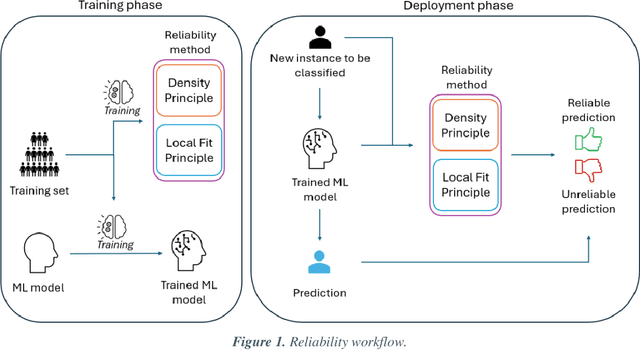

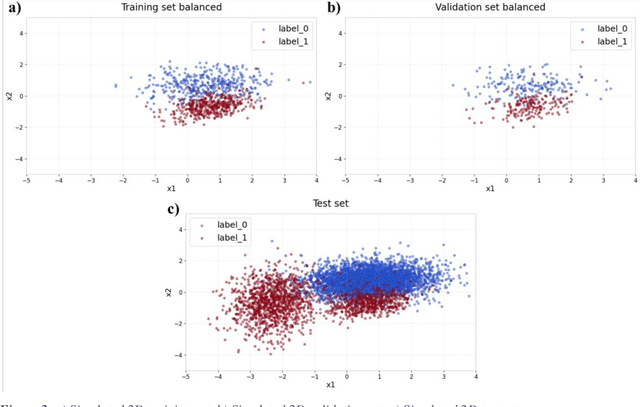
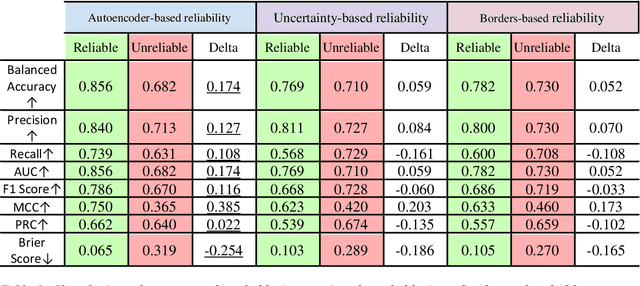
Abstract:Applying Artificial Intelligence (AI) and Machine Learning (ML) in critical contexts, such as medicine, requires the implementation of safety measures to reduce risks of harm in case of prediction errors. Spotting ML failures is of paramount importance when ML predictions are used to drive clinical decisions. ML predictive reliability measures the degree of trust of a ML prediction on a new instance, thus allowing decision-makers to accept or reject it based on its reliability. To assess reliability, we propose a method that implements two principles. First, our approach evaluates whether an instance to be classified is coming from the same distribution of the training set. To do this, we leverage Autoencoders (AEs) ability to reconstruct the training set with low error. An instance is considered Out-of-Distribution (OOD) if the AE reconstructs it with a high error. Second, it is evaluated whether the ML classifier has good performances on samples similar to the newly classified instance by using a proxy model. We show that this approach is able to assess reliability both in a simulated scenario and on a model trained to predict disease progression of Multiple Sclerosis patients. We also developed a Python package, named relAI, to embed reliability measures into ML pipelines. We propose a simple approach that can be used in the deployment phase of any ML model to suggest whether to trust predictions or not. Our method holds the promise to provide effective support to clinicians by spotting potential ML failures during deployment.
Advancing Italian Biomedical Information Extraction with Large Language Models: Methodological Insights and Multicenter Practical Application
Jun 08, 2023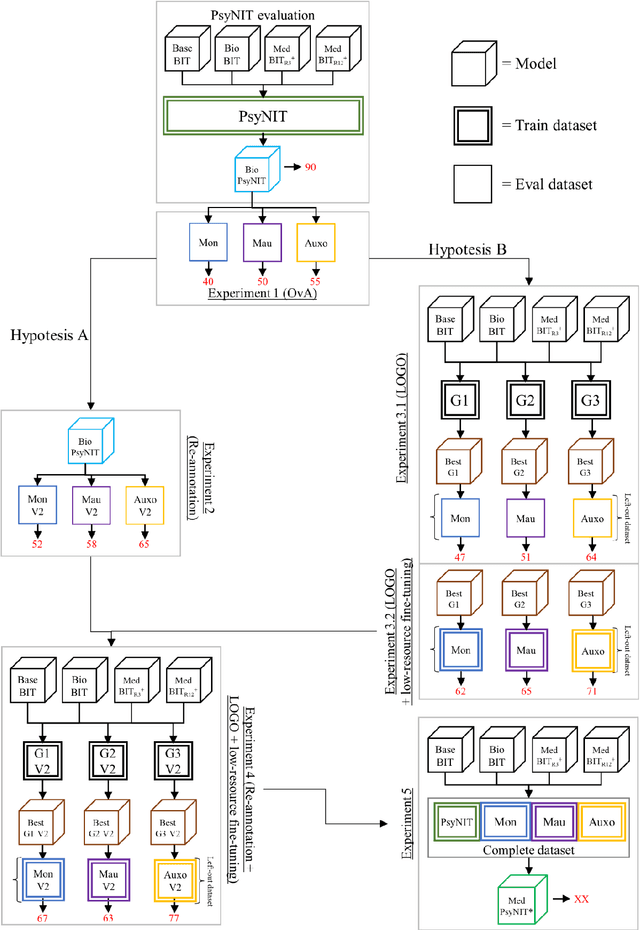


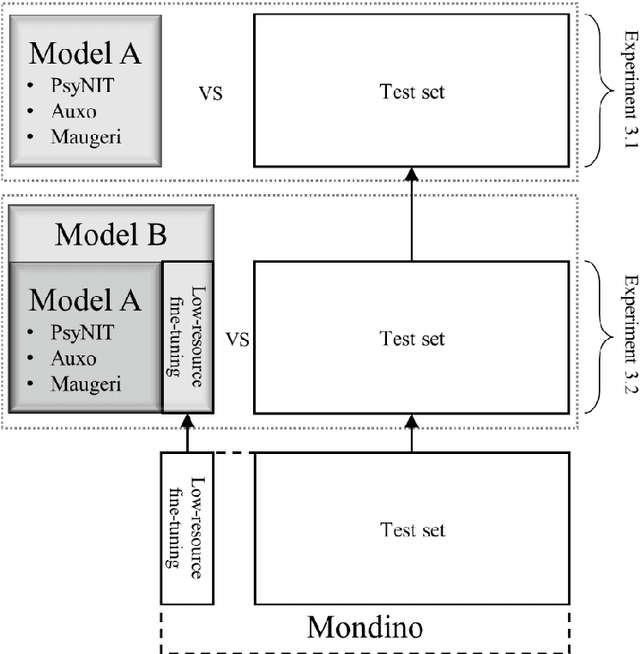
Abstract:The introduction of computerized medical records in hospitals has reduced burdensome operations like manual writing and information fetching. However, the data contained in medical records are still far underutilized, primarily because extracting them from unstructured textual medical records takes time and effort. Information Extraction, a subfield of Natural Language Processing, can help clinical practitioners overcome this limitation, using automated text-mining pipelines. In this work, we created the first Italian neuropsychiatric Named Entity Recognition dataset, PsyNIT, and used it to develop a Large Language Model for this task. Moreover, we conducted several experiments with three external independent datasets to implement an effective multicenter model, with overall F1-score 84.77%, Precision 83.16%, Recall 86.44%. The lessons learned are: (i) the crucial role of a consistent annotation process and (ii) a fine-tuning strategy that combines classical methods with a "few-shot" approach. This allowed us to establish methodological guidelines that pave the way for future implementations in this field and allow Italian hospitals to tap into important research opportunities.
Localising In-Domain Adaptation of Transformer-Based Biomedical Language Models
Dec 22, 2022Abstract:In the era of digital healthcare, the huge volumes of textual information generated every day in hospitals constitute an essential but underused asset that could be exploited with task-specific, fine-tuned biomedical language representation models, improving patient care and management. For such specialized domains, previous research has shown that fine-tuning models stemming from broad-coverage checkpoints can largely benefit additional training rounds over large-scale in-domain resources. However, these resources are often unreachable for less-resourced languages like Italian, preventing local medical institutions to employ in-domain adaptation. In order to reduce this gap, our work investigates two accessible approaches to derive biomedical language models in languages other than English, taking Italian as a concrete use-case: one based on neural machine translation of English resources, favoring quantity over quality; the other based on a high-grade, narrow-scoped corpus natively written in Italian, thus preferring quality over quantity. Our study shows that data quantity is a harder constraint than data quality for biomedical adaptation, but the concatenation of high-quality data can improve model performance even when dealing with relatively size-limited corpora. The models published from our investigations have the potential to unlock important research opportunities for Italian hospitals and academia. Finally, the set of lessons learned from the study constitutes valuable insights towards a solution to build biomedical language models that are generalizable to other less-resourced languages and different domain settings.
 Add to Chrome
Add to Chrome Add to Firefox
Add to Firefox Add to Edge
Add to Edge